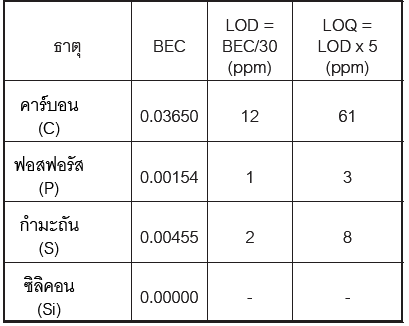Method validation for determination of chromium, nickel, manganese, molybdenum, silicon, carbon, phosphorous and sulfur in stainless steel using spark emission spectrometry
DOI:
https://doi.org/10.60136/bas.v2.2013.273Keywords:
Method validation, Spark emission spectrometry, Stainless steelAbstract
Stainless steel is Iron alloy which is widely used to produce a variety of consumer products. Analysis of chemical compositions which can be used as complementary Information to consider type of stainless steel can be performed by standard test method for Atomic Emission Vacuum Spectrometric Analysis of Stainless Steel by Point-to-Plane Excitation Technique. E 1086-08 in Annual book of ASTM standard (1). To use this standard test method in testing laboratory, it is necessary that the laboratory has to validate this test method according to the requirement of ISO/IEC 17025 to evaluate if the validated method is fit for intended use. Method validation for the determination of chromium, nickel, manganese, molybdenum, silicon, carbon, phosphorous and sulfur in stainless steel using spark emission spectrometry technique can be done through proofing of certain perfomance characteristics which are limit of detection (LOD), limit of quantitation (LOQ), working range, bias, precision and drift (or long-term stability). Then Information obtained from the method validation can be used to assess competence of the laboratory and to estimate measurement of uncertainty of the method. It was found that LODs and LOQs of trace elements (SI, C, P and S) in stainless steel are less than 12 and 61 ppm. For bias study recoveries of eight elements were 92-105 %, while relative standard deviations from precision study of these elements were less than 8 %. The expanded uncertainties of eight elements, at the confidence level of 95%, by this method were less than 20 % which is the maximum target uncertainty. Therefore this validated method is fit for intended use.
References
American Society for Testing and Materials. Standard Test Method for Atomic Emission Vacuum Spectrometric Analysis of Stainless Steel by Point-to-Plane Excitation Technique. E 1086-08. in Annual book of ASTM standard: Section 3, Vol. 03.05 : ASTM, 2008, p. 598-602.
Thomsen, V. B. E. Modem Spectrochemical Analysis of Metals: An Introduction for users of Arc/Spark Instrumentation. ASM International: The Materials Information Society. 1994.
V J Barwick and S L R Ellison, VAM Project 3.2.1 Development and Harmonisation of Measurement Uncertainty Principles Part (d): Protocol for uncertainty evaluation from validation data, Version 5.1, January 2000.
Eurachem Guide: The Fitness for Purpose of Analytical Methods, A Laboratory Guide to Method validation and Related Topics, First edition, Laboratory of the Government Chemist, London, United Kingdom, 1998.
American Society for Testing and Materials. Standard Practice for Use of Statistics in the Evaluation of Spectrometric Data. E 876-Reapproved 94. In Annual book of ASTM standard: Section 3, Vol. 03.05: ASTM, 2002, p. 707-722.
American Society for Testing and Materials. Standard Practice for Evaluating on Optical Emission Vacuum Spectrometer to Analyze Carbon and Low-Alloy Steel, E 1009-95 (Reapproved 2006). In Annual book of ASTM Section 3. Vol. 03.05. West Conshohocken : ASTM, 2008, p. 623-626.

Downloads
Published
How to Cite
Issue
Section
License
Copyright (c) 2013 Bulletin of Applied Sciences

This work is licensed under a Creative Commons Attribution-NonCommercial-NoDerivatives 4.0 International License.









